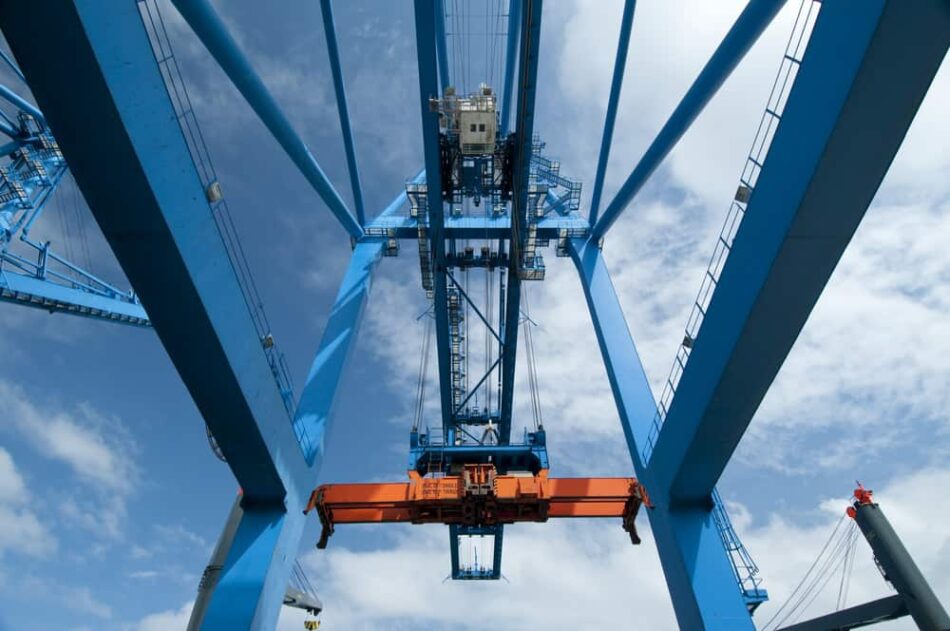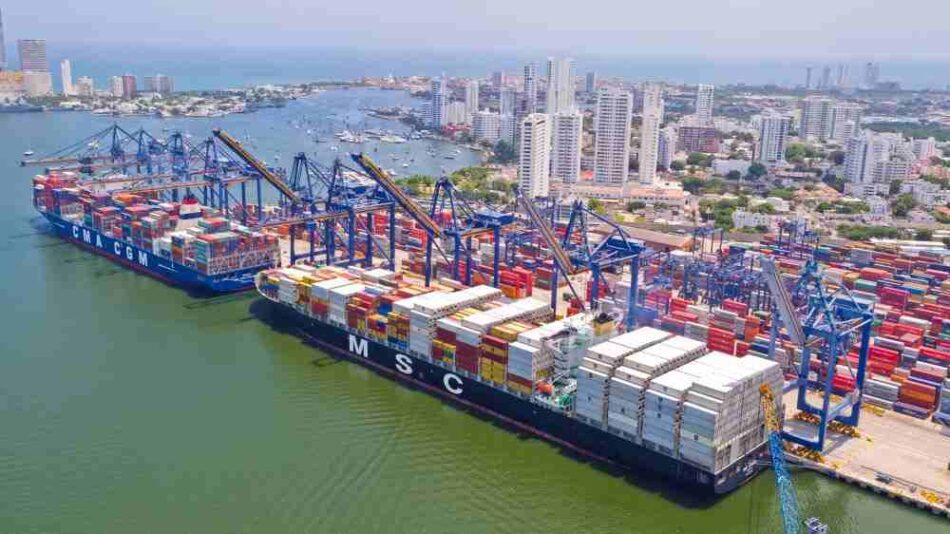Inside box shipping’s Caribbean ‘transshipment triangle’
By Greg Miller From Freight Waves

IMAGE: Shutterstock
When most people think of the Caribbean, they think hammocks strung between rustling palm trees, rum and Coke with more rum than Coke, white-sand beaches, turquoise waters – relaxation.
When ocean shipping and terminal executives think of the Caribbean, they see a fierce battleground, a fight for customers among shifting alliances, a relentless struggle to secure razor-thin profit margins.
It’s easy to forget amidst the rickety beach shacks, reggae bands and palm fronds, but what happens in the Caribbean is enormously important to the global container shipping sector.
The Caribbean is, after all, the crossroads of the Americas. Mainline east-west services from Asia to the U.S. East and Gulf Coast ply the Caribbean after transiting the Panama Canal, as do high-volume service strings connecting the west coast of South America (WCSA) to Europe, and the north-south services linking the U.S. with Brazil.
The Caribbean is the ‘Singapore’ of the Americas. It’s the central hub-and-spoke transshipment nexus of the two continents, where mainline vessels on crisscrossing routes offload boxes at specialized terminals for reloading onto other mainliners or smaller ‘feeders.’
And here’s where the chess game gets really interesting – there are nine major hubs all scrambling for the same liner customers within the so-called Caribbean ‘transshipment triangle.’
The top hubs are: Freeport, Bahamas, operated by Hong Kong’s Hutchison; Kingston, Jamaica, under concession to French liner CMA CGM; Caucedo, Dominican Republic, a joint venture between Dubai’s DP World and local interests; Cartagena, Colombia terminals owned by SPRC; along Panama’s Caribbean coast, Manzanillo International Terminal (MIT), owned by Carrix; CCT, owned by liner company Evergreen; and Cristobal, operated by Hutchison; and along Panama’s Pacific coast (which is not geographically in the Caribbean but is integral to the region’s network), Balboa, run by Hutchison; and PSA Panama, run by Singapore’s PSA.
Some of these hubs are in bed with specific liners via equity deals. Others are playing the field. Each competes with the other on price per transshipment move and on efficiency of service.
The stakes are very high for the terminals. A Caribbean hub can spend millions building out its facilities only to have its top liner customer switch to a competing port overnight, rendering its post-Panamax gantries idle.


SPRC’s Manga terminal in Cartagena. Photo courtesy of SPRC
The stakes are also very high for the liner operators and cargo shippers. A hurricane destroying a Caribbean hub, or a strike by local port workers, can reverberate across the entire Atlantic Basin container-shipping network. A productivity breakdown at one hub in the islands can be felt by everyone from fruit importers in Rotterdam to clothing retailers in New York City to drayage truckers in Charleston.
To understand the current issues, trends and challenges within this crucial corner of the world’s supply chain, FreightWaves interviewed Juan Carlos Croston, the president of the Caribbean Shipping Association and a vice-president at Panama’s MIT.
Major changes on South America-Europe route
“Five or six years ago, before the [Panama] Canal expansion opened, people were saying that the vessels were going to get bigger so there would be fewer direct calls and more transshipment,” said Croston. “That didn’t come true [immediately after the larger canal opened in 2016]. We saw upsizing of vessels but we saw only minor reconfigurations of service networks.
“But now we are seeing it. It took longer than expected, but it’s happening. The new changes are creating 300,000 TEU [20-foot-equivalent units] of additional transshipment in the market as we speak. That’s huge.”
As it turned out, the instigator of change was not the Panama Canal expansion, it was ownership consolidation, specifically the 2017 takeover of Germany’s Hamburg Sud by Denmark’s Maersk Line.
Hamburg Sud was previously a partner in the largest WCSA-Europe service, known as Eurosal, together with CMA CGM, Hapag-Lloyd and COSCO. As part of the approval process of the Maersk deal, Hamburg Sud had to leave Eurosal.
Hamburg Sud and Maersk launched a rival service to Eurosal called CLX in late May, and Eurosal members had to reconfigure services given that Hamburg Sud had accounted for a significant portion of Eurosal’s previous volume. “That triggered a whole reconfiguration of services,” Croston told FreightWaves.


These service changes are leading to a significant increase in transshipment on the Caribbean side of the Panama Canal, and importantly, because of the WCSA’s focus on exports of fruits and seafood, it involves transshipment of more perishable products.
“Everyone has to be on their toes because most of this transshipment is perishable products,” said Croston. “You can’t afford to have service breakdowns, so the pressure is on the hubs. They have been praying for more transshipment, but this could be a case of ‘be careful what you wish for.’ With perishable products, you have to perform. You have to make sure all the windows are aligned and all the protocols are followed. Keeping this [new transshipment business] all depends on providing reliable service.”
Diversification of hubs
When the Maersk-Hamburg Sud deal was announced, there was considerable speculation within Caribbean shipping circles about whether the combined group would opt for one hub, not two. Maersk traditionally transshipped at MIT in Panama; Hamburg Sud at SPRC’s Cartagena terminals.
Croston believes both MIT and SPRC will keep the business despite the takeover of Hamburg Sud by Maersk. “Why would they shut themselves out from having two options? There may eventually be some preference for one or the other, but we don’t see Maersk saying, ‘We’ll go 100 percent with one vendor,’” said Croston.


The same diversification logic applies for the big east-west alliance services that traverse the Caribbean. For example, in the 2M alliance between Maersk and Mediterranean Shipping Company (MSC), Maersk transships at MIT but MSC transships at PSA Panama and Freeport. In the Ocean Alliance, CMA CGM transships at Kingston, while alliance partner Evergreen transships at CCT.
The individual allegiances of various alliance partners to specific terminals are undercutting some of the potential synergies of being a part of an alliance, which begs the question of whether the alliances will someday consolidate their hubs.
According to Croston, “I don’t think carriers want to depend on just one vendor for their transshipment, and with alliances, I think it is very difficult to align all the partners, so I believe we will continue to see this [alliance partners using different hubs in the Caribbean].”
Too much port capacity?
Another key issue in the Caribbean transshipment sector is excess port capacity. Too much capacity at hubs lowers the rate for transshipment services and pressures all of the hubs’ margins.
Most of the hubs expanded capacity significantly coinciding with the Panama Canal project, bringing in cranes that can handle larger container ships, deepening water depths and bolstering yard space. Another wave of new capacity ensued in more recent years, with additions in Kingston and Caucedo, as well as the reconstruction of the Freeport terminal after the hurricane strike in 2016. Meanwhile, an entirely new transshipment facility is under construction by Chinese interests on the Caribbean side of Panama (although construction is reportedly going slower than expected).
Asked by FreightWaves whether Caribbean transshipment capacity is unhealthily high, Croston replied, “Right now, you’re looking at utilization levels [at Caribbean hubs] of between 50 and 55 percent. On one hand, you could argue that there is 45 to 50 percent overcapacity. But on the other hand, the sweet spot for productivity at transshipment hubs is 65 to 70 percent. Once you reach those thresholds, you have to be very careful, so you could also argue that overcapacity is only 10 to 20 percent.”
Furthermore, for transshipment terminals to be true ‘players,’ they need that extra capacity in their back pocket to offer to prospective future liner customers.
“The shipping lines are very clear. They say they’re not going to guarantee anything, but you have to make the investment to be ready,” said Croston. “Financing-wise, it’s very difficult to say ‘build it and they will come,’ but that’s basically what we’re looking at now. You have to build it and you have to be ready for shipping lines to add transshipment volumes to your facility. For the shipping lines, it’s a buyer’s market.”


Despite all of the capacity growth in the region over the past 10 years, Croston said, “I would not be surprised, because of these new developments [increased transshipment volumes for WCSA-Europe cargoes], if some terminals in the Caribbean started moving forward with some new investment plans.”
The incentive for hubs to win new transshipment business is higher than ever in 2019.
A transshipment port can gain volume in two ways – first, from incremental cargo flows due to higher economic activity among exporters and importers, and second, from an increased share of the same volume of containers that do not get delivered non-stop, but are instead transshipped.
According to Croston, the first business source is now less likely. “Mexico, Argentina and Brazil are doing badly [in economic terms]. The economic situation overall in Latin America, outside of some pockets of hope, is not encouraging. If you’re a hub and you’re depending on these economies to drive your volumes, it’s going to be very difficult. It’s the hubs that get additional transshipment volumes from the network changes that are going to succeed.”
For more on this story go to: https://www.freightwaves.com/news/inside-container-shippings-caribbean-transshipment-triangle
For more about cranes go to: www.etihadcranes.com
See also: https://internationalforwarding.co.uk/services/freight-forwarding/groupage-transport/





